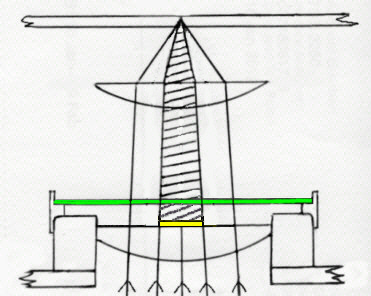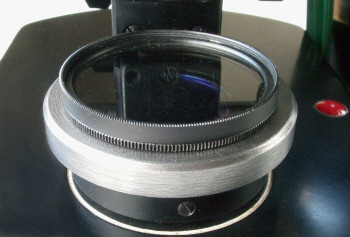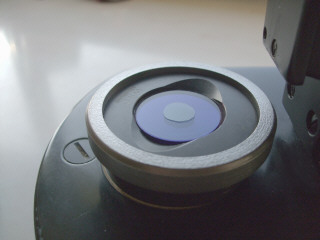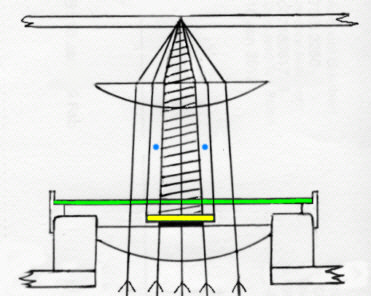| A Seamless Broadfield Condenser (Pt 3)
Refinements : The Polar Route By Paul James |
Having lived withthe MK 1 DIY condenser for several weeks now, I've found no need to modify it any further. It is a joy to use in the realm of mounted slides throughout the objective range in conjunction with or without a small stop on the field lens of the Wild M20.
The optical properties of the Mk11 condenser (the ex Vickers Achromat 1.3na wthout its top lens) were very much to my liking too in the realm of aquatic observations. With a suitably sized stop on the field lens of the Wild M20's stand it raised commendable imagery though the BF/COL/DF range from the Wild Plan-Fluotar battery of objectives. It was a satisfying setup, but I knew it was capable of a little more versatility despite its lack of excess na over the x40 objective which was unable to render DF. But the loss of DF capability with the x40 wasn't an issue for me as I am not that enamoured with high power DF anyway, principally because it can often raise erroneous views of protists , especially in crowded live situations in relatively deep water. For me therefore this lack of DF at the top end of the power range was no loss : I still had its full potential capability in BF/COL. When required the high power scrutiny of objects in ideal settings can be left to the very capable Leitz Heine condenser which musters exquisite detail in COL/DF with maximum 1.4na potential.
Another Watershed
So far I'd been able to tweak each of the 2 condenser's stops to my liking, but a niggling desire to extend this principle of illumination with field lens stops was beginning to develop.
I was now accustomed to the situation of altering the condenser's elevation which controlled the stop's apparent diameter and thus the illumination form and quality of the image. But a single fixed diameter stop gives rise only to a fixed range of imaging options. It seemed to me to that it would be a useful facility to be able change the stop's real diameter in situ, which in turn would effectively extend its apparent size even further, and so bolstering imaging quality at the margins of the objective battery. I did not want to change stops on the field lens in mid observation as the whole point of all this was to create a user friendly variable lighting technique that was intuitive to operate without having to look at the substage controls in the same way a woodwind player's fingers articulates the keys of the instrument without being able to see them. Besides which time would be spent centering the alternative stop which totally nullifies the principle of what I was trying to achieve.
The Conventional Approach ?
I'd thought of a number of mechanical contrivances such as a rotating circular platform supporting several stops of differing diameters along similar lines to a phase condenser's rotating Zernicke disc, but the work involved even to make a mockup would be complex and I didn't know at that time whether is was worth that sort of commitment. Initially a simpler option was required and preferably low cost which would reveal the sensibility or weakness of this idea .
The Solution : Testing the Crossed Polar Principle
What did occur to me was to replace the conventional opaque field lens stop with a stop of the same diameter but fashioned from a piece of polar sheet. When centred over the field lens it would be capable of becoming opaque by the action of another polar filter in the illumination train. All I had to do therefore was to mount a circular polarising filter above, then rotate it to generate the crossed polar effect :-
|
|
The setup, roughly illustrated above, shows the simple arrangement of the polar 'stop' on the field lens. The larger polar disc is shown covering the whole output from the lamphouse. The latter is housed in a circular sleeve that fits neatly over the outer rim of the field lens housing.
|
|
|
The actual assemblage is shown above which sports a more robust outer sleeving than the diagram indicates, which proves to be easier to locate and manipulate during observing sessions. The image on the right reveals my preferred blue filter in the illumination train beneath the polar stop. I obtained a cheap camera circular polar filter (£4.20 ! ) because its optical flatness was not a priority in this role, though its rotatable mounting was a bonus which fortunately reduced my work of adapting it to a minimum.
The Crossed Polar Stop Principle
Though the crossed polar technique is an entirely different method of blanking off the illumination's central core, the principles of multi illumination options raised from different condenser elevation settings are exactly the same as before. The singular advantage of the polar switching stop over the permanent opaque stop is that it allows normal unadulterated BF to be selected by default when the upper polar filter is returned to its neutral position. It also has the additional advantage of enabling the observer to gradually alter the opacity of the polar stop which can raise useful effects at any of the condenser's elevation settings. In fact the utter simplicity of this setup belies the extent of the subtle illumination variations that it can elicit in conjunction with the condenser's elevation setting. So by chance I'd stumbled upon what I considered was a much more useful substage setup than the intended 2 stop variation......... seamlessly flowing through all lighting disciplines BF : COL : DF was now assured.
The Original Intention of a 2 Stop Option
As an alternative to the BF/COL/DF option above, the crossed polar technique can be arranged to provide switching between 2 stops, one being of course the polar stop and the other the conventional stop both coincidently centred on the optical axis :-
|
|
In principle, the setup is identical to the first one but with a conventional opaque stop placed either above or below the polar stop, with the latter of course being the larger of the two. Thus rotating the camera polar filter will raise 2 individual stop sizes in sequence. The wider polar 'stop' broadens the permanent central dark zone by a margin as illustrated above. The effect of this is to broaden the darkfield shadow for the lower power objectives, as well as dumping a greater proportion of the central light from the higher power objectives when employing COL ......all subject of course to the elevation setting of the condenser. The diameters of the 2 stops would reflect the personal priorities of the observer, which in this particular case would exclude pure BF illumination as one option, but allows broader variations of COL/DF illumination.
Crossed Polar Limitations
The range of illumination variants generated from the crossed polar technique is limited to the constraints of the 2 options available : the simple "ON/OFF" scenario. However with careful thought a satisfying substage setup can be arrived at that entirely suits the individual. For my particular circumstances the switching on and off of the polar stop, as described in the first example, is ideal for my aquatic pursuits. The sizing or gauging of the width of the polar stop is the critical part of the process and was simplified by starting with a larger stop than required, then paring it down to the preferred diameter by trial and error.
The Guilding of the Lily
With such an array of lighting options that can be implemented by finger tip control, it seems logical to try to include oblique illumination too. The problem here is that by using up the 'either or option' of polar switching any further introduction of illumination changes would have to be operated by other mechanical means. Manual implementation can raise the oblique effect by lateral adjustment of the condenser or by partially masking the central core of lighting light at the anterior focal length of the condenser. Since the centralisation of all the optical/stop components.....ie the collimation of the entire optical train is particularly critical in this personal lighting enterprise, the additional complexity of offsetting the condenser to raise oblique makes collimation an even more critical requirement to keep in check, unless the condenser in question has the inbuilt facility of off setting and accurate re-registration. For the time being I employ a simple cutout that can be inserted across the condenser's iris plane for oblique effects.
Concluding Thoughts
I apologise if the title 'A Seamless Broadfield Condenser' has become inaccurate by now, but during my escapades with the substage I followed my instincts and ended up with the 2 modified condenser systems. Each had been tweaked as far as I was able to achieve by simple means and limited resources etc.. On reflection a more accurate title might have been " The Poorman's Heine Condenser " for there are imaging similarities between the diy condenser/stop system I've described and the illustrious Heine condenser, though the latter was principally designed to raise Phase Contrast.
There is I believe an inertia in microscopy which has more to do with human nature than anything else. The convention of amateur microscope practice has been firmly centred around Critical/Kohler illumination now for well over a century. There is little wrong with it in principal, but I'd have thought by now there would have been an alternative to the pedantic process of changing illumination disciplines to a more conveniently and rapidly implemented system without any optical compromise? I believe that the immense longevity of practice of iris diaphragm controlled brightfield illumination has more to with convention than sensibility for it to have singularly laboured for so long without material change. I'm not an advocator of convention for convention's sake, and so wonder why in the realm of microscopy manufacturers have not ventured further, though I have been aware in the past of a small number of substage developments that have in the main fizzled out presumably because of a degree of reticence from the core of diehards in microscopy, who by decree it seems have only eyes for the status quo.
In conventional photography we have witnessed many revolutions, one of which involved the emergence of the zoom lens. It didn't replace the standard lens entirely, but offered photographers the option of having convenience and speed of altering perspective and field size with fair image quality.
Amateur astronomers have been more favourably rewarded too in the relatively recent times of the 1960's when the compact Schmidt Cassegrain telescope was designed and manufactured, revolutionising observational convenience with respectable image quality. The mass production of the corrector plate in this form of instrument was at that time an awesome task, but it was nevertheless eventually achieved with aplomb.
So why I wonder hasn't microscopy paralleled a similar advancement in substage illumination which could have taken the cobwebs off and provided an all in one user friendly substage optic who's output could spontaneously illuminate the quarry with any one of a variety of appropriate lighting disciplines by the mere tweaking of the fingers, leaving the eyes exactly where they are meant to be ? I'd have thought that a 0.9 na seamless wide field condenser and its attendant stop mechanisms would be a comparative piece of cake for any manufacturer to design and produce, and profitable at that ?
I suspect that the real culprit in all this inertia in microscopy is the prepared slide. It has understandably fostered a laid back approach to microscopy practice that has remained to this very day. I have several that are over 150 years old. In that time very little has changed in microscopy for the amateur, aside the fact that there are now many more prepared slides than ever ! Those individuals who sustain their microscopy interests from the observations of static preparations have no problems regarding time taken to change illumination disciplines. On the other hand, the live aquatic critters beneath the coverslip have no time to stand still ! Thus the imperative for near instant illumination changes. I rest my case.
| All comments welcome by the author Paul James |



